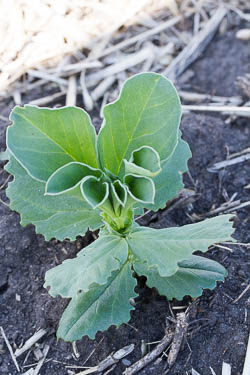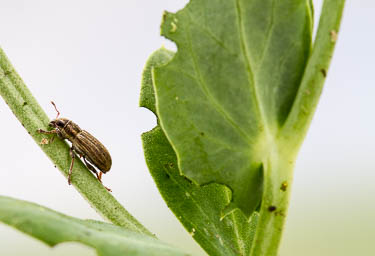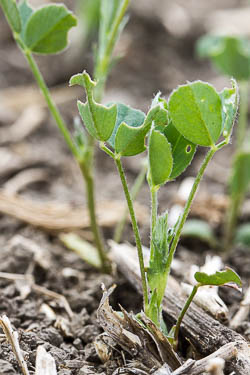| |
 . .
| Evidence of feeding in 2016 once again was over a wider range than in 2015. The range of pea leaf weevil has expanded dramatically in central Alberta since 2013.
The annual pea leaf weevil (Sitona lineatus L.) survey was carried out in late May and early June, 2016. The 2016 survey was based on damage ratings in 168 fields from 41 municipalities.
In each field the total notches per plant are counted on 50 plants (10 plants in 5 locations near the field margin). The damage rating for a particular field is the average number of notches per plant. Information about the pea leaf weevil and its life cycle can be found here. | |
Range expansion of pea leaf weevil from 2011 to 2016.
Overall the severity of pea leaf weevil feeding damage was slightly higher compared to 2016. This is true in all areas of Alberta where pea leaf weevil had previously been established. Pea leaf weevil is now established from southern Alberta through west-central Alberta as far north as Sturgeon County north of Edmonton. While this is not a strict forecast, experience has shown us that activity levels greater than 9 notches per plant is sufficient to cause significant damage if conditions are favorable in the spring of 2017. This covers a large area of southern and west-central Alberta.
The most severe damage in 2016 were in areas southeast and northwest of Lethbridge and in central Alberta between Highway 2 and Highway 21 from Calgary to north of Lacombe. For any producers south of Highway 9 and along Highway 2 up to Edmonton there is a risk of damaging levels of pea leaf weevil in 2017. Producers should use this information along with their own experience to plan control strategies such as seed treatment for the 2017 crop year. Research has shown that seed treatment is much more effective in reducing losses from pea leaf weevil than foliar treatments.
In addition, since 2014 significant pea leaf weevil damage has been seen on fababeans in a much larger area than shown in this survey that is conducted on field peas. This insect causes as much or more damage on fababeans. The true economic damage of this insect on both peas and fababeans on the higher organic matter soils of central Alberta is not well understood but research has been initiated to work out these relationships.
Some VERY low levels of feeding damage were once again found in throughout eastern central Alberta. This damage is so low that there is no risk of serious issues with pea leaf weevil throughout central Alberta in 2017. It will be important to watch the development of these populations over the next few years. Survey locations shown with black circles had no evidence of pea leaf weevil feeding on any of the plants assessed.
Based on studies of pea leaf weevil biology, moisture in August appears to be a significant predictor of increases in the population. Together this information suggests that pea leaf weevil has the potential to be a very important pest in 2017.
Spring weather conditions have a very large impact on the timing and severity of pea leaf weevil damage. When warm conditions (>20 C) persist for more than a few days in late April or early May the weevils arrive in fields early. Early arrival corresponds to the potential for higher yield losses. In years where cool weather persists, the arrival of PLW can be much later and the resulting yield impact appears to be lower especially when the crop advances past the 6 node stage before weevils arrive. In every case control decisions should be made on a field by field basis.

Feeding damage on faba bean
Shelley Barkley, Alberta Agriculture and Forestry |

Pea leaf weevil and feeding damage on field pea
Shelley Barkley, Alberta Agriculture and Forestry |

Feeding damage on seedling alfalfa
Shelley Barkley, Alberta Agriculture and Forestry |
Life cycle information
Frequently Asked Questions
Historical pea leaf weevil forecast maps from 2008-2016.
The 2016 pea leaf weevil survey was carried out by Alberta Agriculture and Forestry technicians.
Thank you David Giffen, Agriculture and Agri-Food Canada, Saskatoon for building the map.
Thank you Jan Lepp, Alberta Agriculture and Forestry for managing the data from this survey.
For more information on this insect and its management contact the Ag-Info Centre at 310-FARM (3276) or email bugs.r.us@gov.ab.ca
|
|